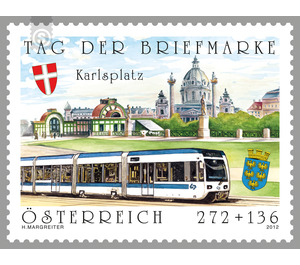day of the stamp - Austria / II. Republic of Austria 2012 - 272 Euro Cent
Theme: Science
| Country | Austria / II. Republic of Austria |
| Issue Date | 2012 |
| Face Value | 272.00 |
| Edition Issued | 640,002 |
| Printing Type | offset |
| Stamp Type | Semi-Postal |
| Item Type | Stamp |
| Chronological Issue Number | 2332 |
| Chronological Chapter | OOS-OE2 |
| SID | 340521 |
| In 57 Wishlists | |
This year's special stamp "Stamp Day" - an additional mark with the denomination 2.72 + 1.36 Euro - shows in its motif on the one hand the Vienna Karlsplatz with the famous Karlskirche and the Otto Wagner built in Art Nouveau subway station, on the other a set of the so-called "Badner Bahn", a local railway that connects the federal capital of Vienna with the Lower Austrian spa town of Baden comfortably. The Karlskirche mentioned above is a Roman Catholic parish church in Vienna's 4th district Wieden. It is located on the south side of Karlsplatz, which is close to the city center, and is one of the most important baroque churches north of the Alps and one of Vienna's most important landmarks. Built between 1716 and 1737, the cathedral was built following a vow made by Emperor Charles VI during the plague epidemic of 1713-1714. Since Karlsplatz was rebuilt as an ensemble in the late 1980s, the imposing Karlskirche not only has a dome and two side relief pillars, but also an architectural counterweight to the buildings of Musikverein and Technische Universität. A historic gem of a very special kind is the striking Art Nouveau building by Otto Wagner. The station Karlsplatz was, in general terms, an architectural special case in the former Viennese light rail network. The aboveground buildings of the initially open station consist of two pavilions richly decorated with ornaments. In contrast to the other stations, they were designed as a steel skeleton construction with suspended marble slabs and decorated in the then extremely modern Art Nouveau style; Incidentally, the flower ornaments were designed by Joseph Maria Olbrich. From each pavilion once led only one stairway departure to each of the two offset side piers. As part of the large-scale transformation work of Karlsplatz, Otto Wagner's aesthetic Stadtbahn station was restored and brought to life as a subway station. The history of the "Badner Bahn" pictured on the brand is also extremely varied and dates back to the late 19th century. Today's operator, the "Aktiengesellschaft der Wiener Lokalbahn" (WLB), transports around 30,000 passengers a day to work, to the school, to the huge shopping center "Shopping City Süd" and to the approximately 30-kilometer stretch between Wien Oper and Baden Josefsplatz various events along the railway line.


